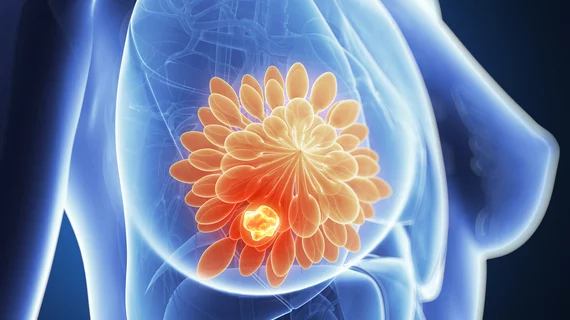Survey unearths significant variation in practice patterns for localizing breast lesions
A new survey has unearthed significant variation in breast localization practice patterns prior to surgery, with healthcare setting a key influencing factor.
Radiologists may deploy a variety imaging modalities and devices to pinpoint nonpalpable breast lesions for removal. Those include wireless methods that allow for enhanced patient comfort and increased flexibility, experts wrote Tuesday in Current Problems in Diagnostic Radiology.
Surveying more than 400 Society of Breast Imaging members about their preferences, researchers received a range of responses. The placement of radioactive seeds to help surgeons locate the area to remove, for instance, was more common among academic practices. And those with higher numbers of mammography readers or radiologists with breast fellowship training were more likely to use novel wireless localization devices and advanced imaging methods.
“Some barriers to more widespread use of these devices and modalities may be related to cost and lack of expertise in using these methodologies,” Sadia Khanani, MD, with the Rochester, Minnesota, Mayo Clinic’s Department of Radiology, and co-authors wrote Jan. 25. “Future studies are needed to further understand and overcome these barriers so that these advanced technologies are widely available across practices.”
Khanani et al. sent out their survey in April 2020, targeting nearly 2,100 physicians for a final response rate of 19%. Respondents represented radiology care settings including academia (31%), private practice with breast specialization (55%) and without (6%) while the rest listed “other.” The vast majority said that radiologists performed needle localizations (91%), with 8% deploying both rads and surgeons, while 1% used nurse practitioners or physician assistants.
As far as methods for breast lesions, most said they performed wire localizations (92%). Wireless modalities included radioactive seeds (18%) and non-radioactive modes such as magnetic seeds (63%). Most radiologists said they routinely localized axillary lymph nodes in patients with breast cancer (60%). Wire localization was one of the most common approaches for such axillary lesions (48%), versus about 14% for radioactive seeds and nearly 50% for other wireless methods such as magnetic seeds. Ultrasound (nearly 99%) and digital mammography (93%) were the most used modalities for localizing breast lesions, while US led the way for axillary lesions (88%). About 34% said they used other methods such as CT or MRI for localizing breast lesions.
Hanani and co-authors noted that adoption of radioactive seeds has been limited, due to nuclear regulatory concerns, costs and potential workflow inefficiencies tied to establishing compliance.
“Given nuclear regulatory complexities involved with radioactive seeds, it is not surprising to see that academic practices and practices with a greater number of radiologists reading mammography and with breast fellowship training were more likely to use radioactive seeds,” the authors noted. “We hypothesize that these practices are more likely to have the resources and the infrastructure to establish nuclear regulatory compliance. Additionally, as nonradioactive wireless devices are emerging, practices are shifting away from radioactive seeds given their regulatory challenges.”

